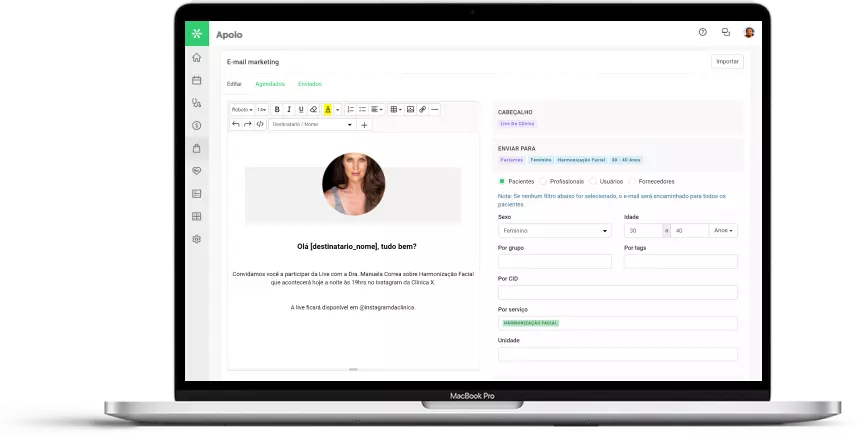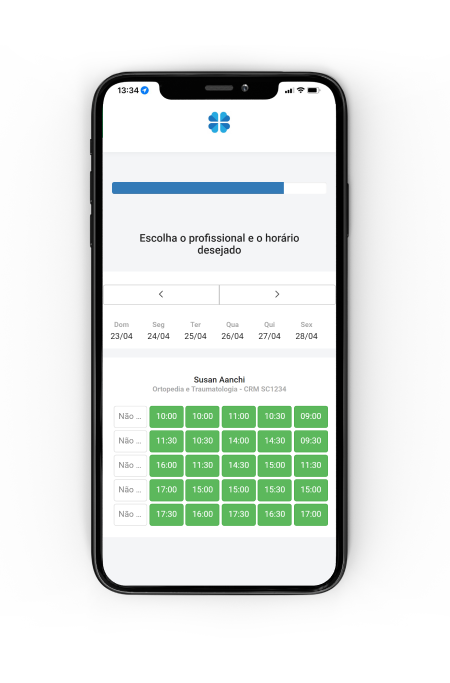
The medical waiting room, often underestimated, is a crucial strategic space in the context of healthcare delivery. This environment plays a significant role in the patient experience, directly influencing their perception of the clinic or office. Moreover, the waiting room offers unique opportunities to boost sales and strengthen the doctor-patient relationship.
By understanding the importance of the waiting room as the first point of contact, healthcare professionals can create effective strategies to engage patients. Ambiance and visual communication play a key role, establishing a welcoming atmosphere that calms anxious patients. The use of modern technology, such as informative monitors and interactive apps, not only reduces perceived wait times but also provides a platform to discreetly promote additional services and products.
Before we continue, have you heard of Ninsaúde Clinic? The Ninsaúde Clinic medical software offers a flexible and comprehensive schedule, personalized electronic medical records for each specialty with legal validity, teleconsultation, financial control, insurance billing, and much more. Schedule a demonstration or try Ninsaúde Clinic right now!
In this scenario, sales opportunities manifest in innovative ways. From promoting wellness programs to advertising specialized services, the waiting room becomes a conducive space to educate patients about the various services offered by the clinic. Digital marketing strategies, such as informative banners and educational videos, can be integrated to inform and persuade patients while they wait.
Apollo Call Panels
In summary, the medical waiting room goes beyond being just a waiting area; it is a strategic space where the first impression is formed, and sales opportunities can be explored ethically and effectively. By understanding the influence of this environment on the patient experience, healthcare professionals can maximize its potential by providing relevant information and establishing connections that benefit both the clinic and the patient.
Understanding the Audience Profile in the Medical Waiting Room
Understanding the audience profile in the medical waiting room is essential for creating a personalized and impactful experience. By analyzing both the demographic and behavioral profiles of patients, healthcare professionals can tailor strategies to meet their specific needs. The diversity of ages, ethnic backgrounds, and health conditions forms a unique panorama, requiring flexible approaches.
Demographic analysis reveals important patterns, from media preferences to comfort levels with technology. For example, while younger patients may prefer digital interactions, older individuals may feel more comfortable with printed materials. Understanding these nuances allows for the customization of communications in the waiting room, making them more effective and relevant.
Additionally, observing behavior during wait times provides valuable insights. Identifying immediate needs and interests of patients creates opportunities to offer relevant information, whether about new services, preventive health programs, or educational resources. Strategies like distributing informative materials and implementing interactive technology can turn wait time into an opportunity for constructive engagement.
In summary, understanding the audience profile in the medical waiting room goes beyond numbers; it is a deep exploration of each patient's uniqueness. Embracing this diversity and adapting approaches not only improves the patient experience but also establishes a more welcoming and individual-centered environment. This personalized approach not only meets patient expectations but also strengthens the bonds between the healthcare team and the community they serve.

Consumer Trends in the Healthcare Sector
The evolution of consumer trends in the healthcare sector reflects the dynamic expectations and needs of modern patients. As people seek a more proactive approach to their well-being, healthcare companies face the challenge of aligning their offerings with consumer expectations. In the medical waiting room, this alignment becomes crucial to providing an experience that goes beyond medical treatment.
Exploring consumer trends reveals a growing demand for convenience, personalization, and accessibility. Patients want easy access to health information, agile services, and personalized options that meet their specific needs. Healthcare companies can capitalize on these trends in the waiting room by offering personalized informative materials, interactive apps, and even virtual consultations to optimize wait times and meet the expectations of modern patients.
Moreover, integrating innovative technologies into the medical waiting room, such as interactive kiosks or informative monitors, provides an effective platform to showcase additional services, wellness programs, and health-related products. By strategically aligning these offerings with consumer trends, companies can not only improve the patient experience but also foster brand loyalty.

Adapted Marketing Strategies for the Medical Waiting Room
The often underestimated environment of the medical waiting room is, in reality, a fertile ground for effective and personalized marketing strategies. Developing specific campaigns for this crucial space can transform patient waiting into a valuable communication opportunity. Whether through informative monitors or strategic printed materials, it is possible to create targeted content that educates, informs, and engages the audience in a relevant manner.
The customization of campaigns begins with a deep understanding of the demographic profile and the needs of patients in the waiting room. By tailoring the message to meet specific expectations and interests, campaigns become more impactful and memorable. Using marketing materials appropriate to the healthcare context is crucial, incorporating accessible language, clear graphics, and pertinent information about available medical services.
Furthermore, the implementation of attractive visual strategies, such as informative videos, can not only reduce the perception of wait time but also highlight special services, promotions, or health initiatives. The waiting room thus becomes a strategic point to reinforce the clinic's brand, build trust, and provide useful information that resonates with patients.
Technological Innovations in the Medical Waiting Room
In the ever-advancing landscape of healthcare, technological innovations play a crucial role in redefining the patient experience in the medical waiting room. Analyzing technological solutions reveals a horizon full of possibilities to enhance not only operational efficiency but also patient satisfaction and sales opportunities. A valuable tool is the Ninsaúde Clinic software, offering comprehensive and personalized management, from appointment scheduling to inventory control and financial management. This solution not only streamlines internal processes but also creates a smoother experience for patients, enabling more efficient care.
Standing out among innovations, the ability to call patients through digital panels during the wait redefines the traditional dynamics of the waiting room. This approach not only reduces anxiety associated with wait times but also provides strategic opportunities to promote additional services. Additionally, the implementation of interactive apps and innovative devices in the waiting room not only keeps patients informed about their queue progress but also provides space for personalized campaigns, promoting wellness programs, and presenting products and services in a non-intrusive manner.
In summary, technological innovations in the medical waiting room are not just process facilitators but catalysts for a more engaging and effective patient experience. By embracing solutions like the Ninsaúde Clinic software and incorporating interactive systems, clinics and offices not only modernize their operations but also transform waiting time into a strategic opportunity to enhance patient satisfaction and boost sales opportunities.

Ethical and Legal Aspects
The marketing of products and services in the healthcare sector requires careful attention to the ethical principles that guide this sensitive sphere of society. Considering health as a fundamental good, ethics in the promotion and sale of products and services becomes a non-negotiable priority. It is crucial for companies to adopt transparent, honest, and fact-based practices when presenting their products to consumers. Public trust in the integrity of the healthcare sector is fundamental to the long-term success of any enterprise.
Beyond ethical considerations, compliance with specific regulations and laws is an essential obligation. Healthcare companies must be aware of and strictly adhere to government standards governing advertising, the sale of medical products, and business practices. This not only protects consumer interests but also safeguards the company's reputation. In the context of healthcare, where responsibility is high, legal compliance is not just a formality but a fundamental pillar for ethical service provision and marketing.
In summary, ethics and legality in the marketing of products and services in the healthcare sector are inseparable. Companies aiming to thrive in this sector must adopt practices that not only meet the highest ethical standards but also fully comply with government regulations. This ethical and legal commitment not only establishes a solid foundation for business but also contributes to building a lasting relationship of trust with consumers, grounded in transparency and responsibility.

Conclusion
In summary, it is clear that the medical waiting room offers vast opportunities to enhance the patient experience. Personalization and innovation, as highlighted by the comprehensive Ninsaúde software, are crucial to meeting the evolving expectations of patients. Embracing patient-centered approaches not only addresses immediate needs but also builds lasting relationships.
By integrating ethical and legal practices, healthcare organizations can not only promote trust but also drive success in the ever-changing industry. Ultimately, the medical waiting room is a strategic point for creating meaningful connections, promoting health, and offering an experience that surpasses expectations, transforming healthcare into a collaborative and effective journey.
Did you find these tips helpful? Keep following the blog for more content like this. Are you a healthcare professional who hasn't yet adopted management software? Explore the Ninsaúde Clinic system.

